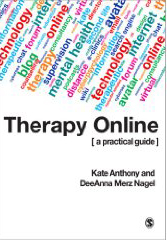
More from DeeAnna Merz Nagel following her WTCI interview–an excerpt from Therapy Online: A Practical Guide, written with Kate Anthony. A brief section below discusses unconditional positive regard and online therapy. Here, links to pdfs of the book’s introduction and first chapter, complete.
Unconditional Positive Regard
from Therapy Online: A Practical Guide
Conveying the potential for the therapist to have unconditional positive regard for the client is a process that can often start before any communication actually takes place when working online, through the use of the website to explain what this means and what regard the therapist already feels for the website visitor without having met them. This sounds facile, but it is the tone that is taken via the text while writing the website content that can convey this. Many people make the mistake of writing website content for themselves and how they would like to be, rather than being congruent (which we shall come on to) and writing for their potential client, considering the likely state of mind of the potential client. One can convey to the client that one expects to hear issues and problems that the client may feel embarrassed or ashamed of, and that as their therapist, one will think no less of them for having shared those issues. The website can state up front that the visitor is held in the utmost regard, that they are accepted and that there is a space for them to explore themselves and grow from the experience while being safe from being judged or ridiculed.
It is important to remember that the client can carry the therapist’s input, literally, at all times, and therefore the text must be carefully constructed to avoid any ambiguous meaning that the client can use to fuel any self-fulfilling prophesies that she or he may have. Conveying unconditional positive regard throughout the email or IRC session can aid the interpretation of the text around it, which is often misread, unconsciously, to suit the client’s agenda (Goss and Anthony, 2003). Acknowledging the client’s worth and one’s respect for them often renders misinterpreted text as incongruent and so the client will go back and re-read the text to better understand the meaning, as the misinterpreted text does not seem to ‘fit’with their experience of the therapist thus far. In this way, the regard the practitioner holds for the client and the ability to ensure she or he understands this, underpins the whole tone of the text.
The online disinhibition effect (Suler, 2004), further defined in Chapter 2 often means that the more distressing or uncomfortable issues come up much earlier than they would in face-to-face sessions, and the practitioner may find that they are struggling with this information before they really ‘know’ the client and are able to feel that the unconditional positive regard is inherently in place.This process is crucial to the effectiveness of the therapeutic process – if one is not able to keep the reassurance of understanding and regard in place, the client will feel that they have ‘gone too far’ and they can be lost, since ‘disappearance’ on the Internet is facilitated so easily. It is important to indicate that, in the case of emails and forums, although a word count or length limit is appropriate, it does not mean that the content of the work is limited. Having unconditional positive regard for them means that you can trust that the pertinence of the work will emerge as the relationship grows, and that even where there is uncomfortable work going on at an early stage, this is not only expected, but welcomed.
Many humanistic or person-centred therapists will convey warmth and regard in a variety of physical ways, including smiling, appropriate touching, or leaning towards the client. Chapter 3 will focus on how this is done when working with text, but it is important to point out now that most of the physical tools that the person-centred therapist employs are entirely possible when working without a physical presence in cyberspace, even appropriate hugging (in fact, particularly the hugging (Anthony, 2000)). It should be noted that representation of physical contact or movement should be encouraged when online to assist the development of the relationship and convey the core conditions of humanism. The consistency of this warmth and regard will be important as the work continues, and any withdrawal of it will rebound negatively on the work. It is therefore essential that all representation of being a physical being is natural and personal, so that it occurs without thought or specific intention, unforced.
From Therapy Online: A Practical Guide by Kate Anthony and DeeAnna Merz Nagel.

Leave a Reply
You must be logged in to post a comment.